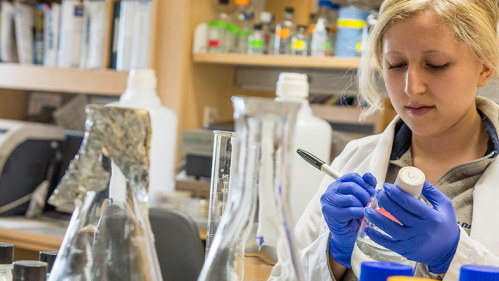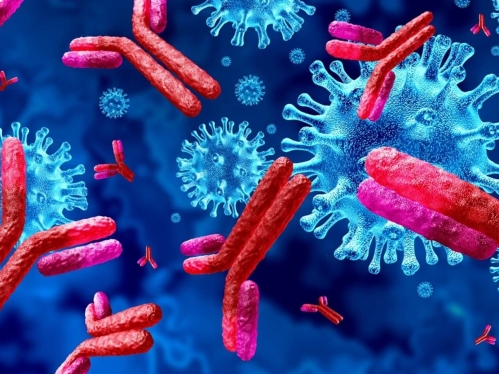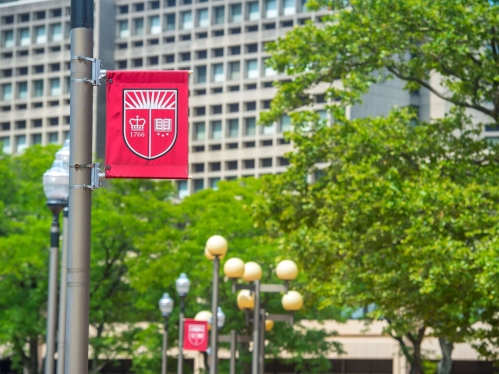
Flow Cytometry & Immunology Core Laboratory
Overview
The Flow Cytometry Core Lab provides support to the NJMS research community as well as to surrounding universities and private companies for applications involving flow cytometric analysis, cell sorting and imaging flow cytometry.

Contact Info
Location: MSB F522

Sukhwinder Singh, Ph.D.

Patricia Fitzgerald-Bocarsly, Ph.D.
Resources Available
-
- BD LSRFortessa X-20 - The Fortessa is equipped with 5 lasers (355nm, 405nm, 488nm, 561nm, and 642nm). It is capable of acquiring up to 18 fluorescent parameters per sample with 3 colors off the 355nm, 5 colors off the 405nm, 2 colors off the 488nm, 5 colors off the 561nm and 3 colors off the 642nm laser. Since the instrument is equipped with the 561nm laser it has the ability to excite RFP, mCherry and number of the other fruit fluorescent proteins. The Fortessa is also equipped with a 96-well pate high throughout system for running plates.
- LSR II air-cooled four-laser benchtop flow cytometer (BD Biosciences Immunocytometry Systems) with the ability to acquire 12 colors. BD digital software (DIVA) provides both online and offline compensation running in a Windows based environment. It includes a solid-state 488nm (blue) laser, a JDS Uniphase 633 HeNe laser (red), a Coherent 405nm laser (violet) and a sold-state 355nm laser (UV) with the ability to detect 5 colors from the blue laser, 3 colors from the red laser, 2 colors from the Violet laser and 2 colors off the UV laser utilizing fiber optic technology.
- Two BD Biosciences FACSCaliburs each having a dual laser capacity (an air-cooled 488 nm argon laser and a red diode laser) with capabilities to do up to four color analysis.
-
- BD FACSAria II SORP: The FACSAria II is equipped with four lasers (355nm (UV), 488nm, 561nm and 640nm), allowing for 12 marker based sorting for clonal expansion, multi-well plating, sorting onto slides and simultaneous 2, 3, or 4 population sorting. With the addition of the 561 nm laser, the sorter is capable of sorting cells expressing the red fluorescent family of proteins including RFP, mCherry, mPlum and others. It is housed in a Baker biosafety cabinet and in addition has an aerosol containment unit built-in, which allows for the sorting of BSL2 agents and virus-infected cells.
- BD FACSAria II (BSL-3): The FACSAria II is located in the BSL-3 Lab in the Center for Emerging and Re-emerging Pathogens and operated as a satellite of the FCICL. It allows for the analysis and sorting of live TB and other agents that require BSL-3 handling along with the ability to analyze the interaction between mammalian cells and those pathogens. The FACSAria II is equipped with two lasers (488 nm and 640 nm) allowing for the simultaneous acquisition of up to 10 parameters. As stated above, the FACSAria is able to sort 4 populations simultaneously or deposit the cells into multi-well plates, as well as the ability to sort cells onto slides.
-
AMNIS ImagestreamX MarkII: The FCICL operates an Amnis ImageStreamX MarkII (Amnis Corporation) imaging flow cytometer that is equipped with four lasers (405, 488, 561, and 642 nm) This instrument, which operates in a Windows-based environment, introduces a new technology platform that captures high-resolution digital images of cells in flow at rates of approximately 1,000 – 2,000 cells/per second. It simultaneously acquires up to 12 different images of each cell, which includes 10 colors of sensitive fluorescence imagery, side scatter and brightfield imagery.. The ImageStream combines the quantification and analysis of cellular morphology with the ability to perform all the fluorescence intensity measurements of conventional flow cytometry, allowing for rapid analysis and classification of thousands of cells using the ImageStream IDEAS software. The IDEAS software calculates over 100 parameters per cell, including all the standard intensity-based parameters and statistics employed in flow cytometry as well as numerous morphological parameters such as cell area, perimeter, aspect ratio, texture, spot counts and internalization ratios. The ImageStream is ideally suited for quantitative investigations of nuclear translocation, phagocytosis, intracellular co-localization, apoptosis, cell: cell interactions and fluorescent in situ hybridization in suspension.
-
- Additional software available for use in multiparameter studies includes BD Bioscience CellQuest for the Caliburs, Modfit LT software for DNA and cell proliferation analysis, HTS software for the HTS sampler, and BDDiva software for the LSRII and the Cell sorter. For the ImageStream, the IDEAS software package is available which can be used in the Flow Cytometry Core Lab at the additional ImageStream workstation. The IDEAS software is also available to UMDNJ-NJMS researchers for use in their laboratories through our site license.
- The Core Laboratory also adminsters a university site license for FlowJo analysis software. Please go to the Charges and Policies link below for pricing and availability.
Facilities use
Equipment time and services at the Flow Cytometry Core Lab are available to investigators on an hourly fee-based schedule.
